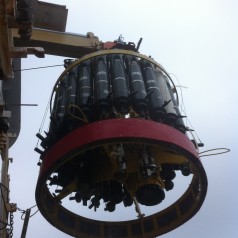The oceanographic rosette

A rosette is not an oceanographic instrument itself. It is a round frame tied to a winch on which different instruments can be mounted. During the AZMP (Atlantic Zone Monitoring Program) cruise in April 2013, the rosette for a typical profile includes two CTDs, two optodes, two fluorometers, two ADCPs (one looking up, the other looking down) and up to 24 Niskin bottles. Sometimes, we used additional space to include other sensors for calibration purposes (e.g. MicroCats).
All of these instruments make in-situ measurements. But sometimes there is no instrument capable of measuring the quantity we are interested in (radioactive isotopes concentration, bacterial analysis, etc). That is why we use Niskin bottles to take water samples. They are tied open in the wet lab and then remotely triggered to seal shut and trap water at a given depth. But you have to make sure you fire these bottles on the way up! If a bottle is sealed on the way down, the extra pressure at depth, compared to the pressure of the sampled water, is going to crush the bottle. While on the way up, the extra pressure of the trapped water can be released without contaminating the water sample.
Once the rosette is back on deck, we transfer the required volume of water into labeled bottles for future processing in the laboratory.

